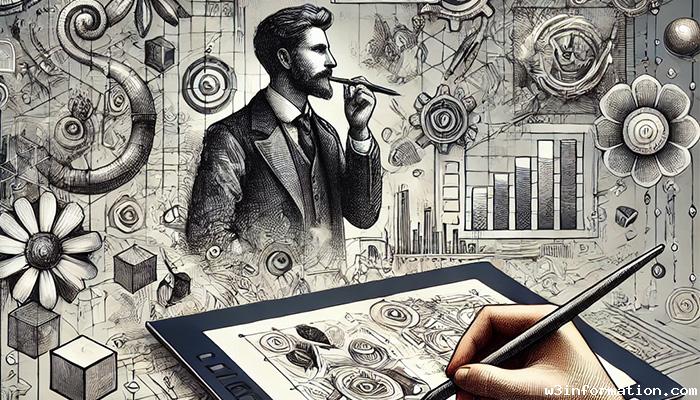The Rise of Digital Art in the Modern World
Artists now frequently use digital art as their primary means of creative expression because it has gained significant prominence in recent years. Advanced technologies paired with digital tool proliferation present artists today with extraordinary opportunities to produce and distribute their artwork. This blog examines how digital art is expanding its influence while becoming part of the mainstream art world and explores how technology changes our perception and appreciation of art.
What is Digital Art?
The term digital art describes any artwork that is produced by means of digital technology. Instead of physical materials such as paint or canvas which traditional art forms depend on, digital art production utilizes computers and software applications along with various digital instruments. The field encompasses multiple artistic methods including digital painting and 3D modeling as well as video art and animation.
Artists commonly use graphic tablets while software such as Adobe Photoshop and Illustrator along with specialized 3D design programs like Blender and Autodesk Maya remains popular. Digital art manifests as static forms like digital paintings or illustrations and takes on animated forms through short films and GIFs while also existing interactively as virtual reality art and interactive installations.

The Evolution of Digital Art
Digital art didn’t appear overnight. Technological advancements combined with artistic exploration have defined the evolution of digital art. The first experiments with computer-generated visual art started in the 1950s and 1960s by innovative pioneers. Artists like Frieder Nake and Harold Cohen used basic computer programming techniques coupled with plotters to produce images which traditional manual methods could not create. The initial experimental works in digital art established groundwork for the advanced digital techniques developed later on.
The emergence of personal computers and graphic design programs such as Adobe Photoshop and Illustrator during the 1980s enabled artists to transition from pixel-based experimentation to producing more polished and intricate artworks. The early 2000s marked a period when digital art gained wider acceptance because more software tools became available and online platforms such as DeviantArt enabled artists to showcase their work to an international audience.
Today, digital art is ubiquitous. Digital art appears in domains ranging from advertising and social media content to video games and film productions as well as online art exhibitions. Artists today enjoy the opportunity to explore limitless creative possibilities because they are not restricted to physical mediums anymore.
The Popularity of Digital Art
Digital art has become extremely popular for numerous reasons throughout recent years. One of the primary reasons is accessibility. Digital art tools offer greater affordability and wider availability than traditional art materials. The price of digital tablets and styluses remains significantly lower than the cost of professional painting supplies. Procreate software enables tablet-based drawing and painting which costs less than standard art supplies making it accessible for new artists to begin their creative work.
Digital platforms including social media expose digital artists to international audiences by serving as global stages for their work. Artists use platforms like Instagram, Behance, and Pinterest to connect with large audiences which helps them build communities and gain recognition for their work. Digital art's ability to spread quickly across the internet has opened up the art world to everyone who owns a computer or smartphone to make and enjoy art.
Digital art now plays an essential role across several sectors such as advertising, fashion, music and entertainment. The widespread use of digital art techniques in video game design, animated films, and music videos has led to the popularization of this art form.
Technology's Influence on Digital Art
Technological advancements have exerted a profound impact on the evolution of digital art. Technology has enabled digital artists to expand their creative possibilities through both software development and hardware innovations.
a. Software Tools
Software remains fundamental to the development and progression of digital art. While initial programs provided fundamental functions for image manipulation and pixel-based design basic programs now offer greatly expanded capabilities. Artists use Adobe Photoshop, Illustrator, and Corel Painter to create professional-level artwork which features detailed representations similar to traditional media tools including watercolor, oil paint, and pencil drawing.
Artists use specialized 3D modeling programs like Blender and Autodesk Maya to build everything from 3D sculptures to complete virtual environments. Digital artists now possess capabilities to create and alter the form, texture, and lighting of their artworks through advanced tools that were unavailable in the past.
b. Hardware Devices
The development of hardware devices that replicate conventional artistic tools has enabled the growth of digital art. Artists can draw on digital canvases using Wacom tablets and styluses which provide precision and control similar to traditional media tools. The development of portable and user-friendly digital art tools like the iPad Pro and Apple Pencil continues to advance tablet technology.
The emergence of augmented reality (AR) and virtual reality (VR) technologies has created new possibilities for digital art expression. Artists use VR software such as Tilt Brush to create three-dimensional art by painting and sculpting within virtual spaces that viewers can experience and navigate. Digital art is evolving into interactive and immersive experiences through the use of advanced immersive technologies.
The Role of NFTs in Digital Art
Non-Fungible Tokens (NFTs) have recently developed into a major movement within the digital art scene. NFTs represent exclusive digital assets which blockchain technology secures to verify authenticity and establish ownership of digital items. Artists now use NFTs to sell digital artworks as exclusive items just like physical art in galleries.
Digital artists benefit greatly from NFTs because they offer proof of ownership and originality for their work. Digital art used to be susceptible to duplication and redistribution because there was no method to confirm the original artist or rightful owner. NFTs address this problem by offering a digital authentication certificate for every artwork.
NFT technology has created new avenues for digital artists to earn money from their creations. Artists have the opportunity to sell their creations directly to collectors without galleries as intermediaries and can establish resale royalties to earn future income whenever their work changes hands. NFTs have created a rapidly expanding marketplace where some pieces reach multimillion-dollar prices during auctions. Digital art has gained prominence through this development which showcases its ability to maintain value within a market that has historically favored physical artworks.
Digital art now stands as a fundamental component of mainstream culture
Digital art serves as an essential component within mainstream culture while shaping both pop culture and marketing strategies. Social media platforms have allowed digital art to reach audiences around the world while millions of users engage with digital art every day.
The use of digital art in video games and films as well as music and advertising continues to strengthen its role within popular culture. Game design utilizes digital art to develop characters alongside environments and visual effects. The entertainment industry showcases digital art through animated films and music videos to improve visual presentation. Brands are increasingly using digital art to produce captivating visuals and campaigns that connect with young audiences who have a strong understanding of technology.
Digital artists now enjoy greater visibility and impact in the creative industry as they work alongside brands and various content creators to develop innovative and captivating audience experiences.
The Future of Digital Art
Digital art will continue to flourish because new technologies keep appearing and changing the creative world. Artificial intelligence along with machine learning and emergent interactive technologies will shape the evolution of digital art in future years.
Artists will likely adopt virtual and augmented reality technologies to design interactive art experiences that engage their audiences differently. Artists now have access to advanced AI tools that enable them to produce complete artworks with minimal input. Digital creators will discover new opportunities to venture into previously unexplored artistic realms because of these advancements.
The ongoing expansion of NFT technology will further integrate digital art into the art market enabling artists to connect with worldwide audiences and offer their pieces directly to collectors without gallery involvement.
Conclusion
Digital art's emergence has revolutionized contemporary perspectives on artistic creation. Digital art started as a niche creative practice but now functions as a mainstream element shaping entertainment and marketing industries. Digital art will continue to increase in significance as technology progresses while providing limitless opportunities for creative and innovative expression. New tools and platforms along with markets like NFTs place digital art in a strong position to stay a major dynamic force in the art world for years to come.
 Top 10 Comfort Foods to Try This Winter
Top 10 Comfort Foods to Try This Winter
 Top 10 Christmas Destinations Around the World
Top 10 Christmas Destinations Around the World
 Navigating Adolescence: Tips for Parents and Teens
Navigating Adolescence: Tips for Parents and Teens
 How to Start a DIY Craft Project on a Budget
How to Start a DIY Craft Project on a Budget
 How to Build Strong Family Bonds in the Digital Age
How to Build Strong Family Bonds in the Digital Age
 The Importance of Early Childhood Education
The Importance of Early Childhood Education